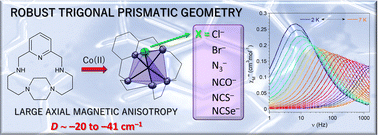Trigonal prismatic coordination geometry imparted by a macrocyclic ligand: an approach to large axial magnetic anisotropy for Co(ii)†
Abstract
Large uniaxial magnetic anisotropy, expressed by a negative value of the axial zero-field splitting parameter D, has been achieved in a series of trigonal prismatic Co(II) complexes with the general formula [Co(L)X]Y, where L = 1,5,13,17,22-pentaazatricyclo[15.2.2.17,11]docosa-7,9,11(22)-triene, X = Cl−(1a,b), Br−(2), N3−(3), NCO−(4), NCS−(5), NCSe−(6), and Y = Cl−(1), Br−(2), NCS−(4), NCSe−(5), ClO4−(3,6). Complexes 1–6 are six-coordinate with the distorted trigonal prismatic geometry imparted by the pentadentate pyridine-/piperazine-based macrocyclic ligand L and by one monovalent coligand X−. Based on magnetic studies, all complexes 1–6 exhibit strong magnetic anisotropy with negative D-values ranging from about −20 to −41 cm−1. This variation in D (i.e. the increase of magnetic anisotropy) parallels the trend obtained by theoretical calculations and the lesser distortion of the coordination sphere with respect to the trigonal prismatic reference geometry. AC magnetic susceptibility investigations revealed field-induced single-molecule magnet behaviour for all complexes except Cl− derivative 1. The series investigated represents a rare example of Co(II) complexes with a robust trigonal prismatic geometry.



 Please wait while we load your content...
Please wait while we load your content...